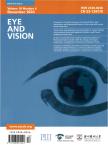A machine learning-based algorithm used to estimate the physiological elongation of ocular axial length in myopic children
作者机构:Department of Ophthalmology&Clinical Centre of OptometryPeking University People’s HospitalBeijing 100044China College of OptometryPeking University Health Science CenterBeijingChina Eye Disease and Optometry InstitutePeking University People’s HospitalBeijingChina Beijing Key Laboratory of the Diagnosis and Therapy of Retinal and Choroid DiseasesBeijingChina Academy for Engineering&TechnologyFudan UniversityShanghaiChina Department of Biomedical EngineeringCollege of EngineeringPeking UniversityBeijing 100871China School of Ophthalmology and Optometry and Eye HospitalWenzhou Medical UniversityWenzhouZhejiangChina
出 版 物:《Eye and Vision》 (眼视光学杂志(英文))
年 卷 期:2020年第7卷第1期
页 面:485-496页
核心收录:
学科分类:1010[医学-医学技术(可授医学、理学学位)] 10[医学]
基 金:This work was funded by the National Natural Science Foundation of China(Grant No.81870684 and 81421004) the HuaXia Translation Medicine Fund For Young Scholars(Grant No.2017-B-001) the Non-Profit Central Research Institute Fund of the Chinese Academy of Medicine Sciences(Grant No.2019HY320001) the National Key Research and Development Program of China(2017YFE0104200) the National Key Instrumentation Development Project of China(2013YQ030651)
主 题:Myopia Myopia progression Machine learning Ocular axial length Physiological elongation Orthokeratology
摘 要:Background:Axial myopia is the most common type of ***,due to the high incidence of myopia in Chinese children,few studies estimating the physiological elongation of the ocular axial length(AL),which does not cause myopia progression and differs from the non-physiological elongation of AL,have been *** purpose of our study was to construct a machine learning(ML)-based model for estimating the physiological elongation of AL in a sample of Chinese school-aged myopic ***:In total,1011 myopic children aged 6 to 18 years participated in this ***-sectional datasets were used to optimize the ML *** input variables included age,sex,central corneal thickness(CCT),spherical equivalent refractive error(SER),mean K reading(K-mean),and white-to-white corneal diameter(WTW).The output variable was AL.A 5-fold cross-validation scheme was used to randomly divide all data into 5 groups,including 4 groups used as training data and one group used as validation *** types of ML algorithms were implemented in our *** best-performing algorithm was applied to predict AL,and estimates of the physiological elongation of AL were obtained as the partial derivatives of AL_(predicted)-age curves based on an unchanged SER value with increasing ***:Among the six algorithms,the robust linear regression model was the best model for predicting AL,with a R^(2) value of 0.87 and relatively minimal averaged errors between the predicted AL and true *** on the partial derivatives of the AL_(predicted)-age curves,the estimated physiological AL elongation varied from 0.010 to 0.116 mm/year in male subjects and 0.003 to 0.110 mm/year in female subjects and was influenced by age,SER and *** to the model,the physiological elongation of AL linearly decreased with increasing age and was negatively correlated with the SER and the ***:The physiological elongation of the AL is rarely recorded in clinical data in




